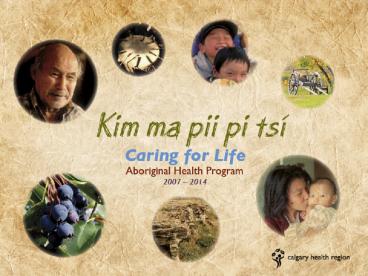Whats Being Described - PowerPoint PPT Presentation
1 / 43
Title:
Whats Being Described
Description:
Develop and implement a process for public participation that privileges the ... supporting a healthy life by honouring ourselves, other people, and mother earth; ... – PowerPoint PPT presentation
Number of Views:50
Avg rating:3.0/5.0
Title: Whats Being Described
1
(No Transcript)
2
Whats BeingDescribed
- Why and how this document was developed
- Whats in it (and whats not)
- Whats next
3
Whats in theName
- Kim ma pii pi tsi
- Blackfoot word
- Can be interpreted/translated as Caring for
Life - Intended to
- recognize local historical territory
- privilege Aboriginal people
4
Why aDocument
Develop and implement a process for public
participation that privileges the Aboriginal
community to inform the directional
document. Communicate the Strategic Intent and
Direction for Aboriginal Health in the Calgary
Health Region.
5
The Aboriginal Health Programs first Directional
Document spanned two years and included a public
participation process. It was the first public
document that described the program and its goals.
6
Audiences
- External
- Community Leaders
- Inform and educate
- Planning tool
- Demonstrate leadership and cultural competency
- Internal Leaders and Managers
- Inform and educate
- Planning tool
- Aligned with Regions Strat Plan and CSD
Create Champions
7
Key messages
- There are many strengths within the Aboriginal
communities - There are significant health disparities
- Customized programs are important
- It is vital and important that Region programs
and the Aboriginal community members work
together as Champions
8
ProjectOrganization
- Project Charter
- Authorized by Executive Sponsors
- Project Steering Committee
- Project Team
9
SteeringCommittee
- Brett Hodson (co-chair)
- Dr. Lorne Clearsky (co-chair)
- Casey Eagle Speaker (Recognized Elder)
- Tyler White (Treaty 7 Health Directors)
- Louise Crane (CUAI Health Domain)
- Janice Popp (SACYHN)
- Cheryl Gardner (Mental Health)
- Kari Simonson (Rural)
- Bretta Maloff (Healthy Living)
- Linda Okanee (Aboriginal Health)
- Chelsea Crowshoe (Aboriginal Health)
10
ProjectTeam
- Brett Hodson (Aboriginal Health)
- Linda Okanee (Aboriginal Health)
- Chelsea Crowshoe (Aboriginal Health)
- Donna Yazlovasky (Aboriginal Health)
- Lindsay Heintz (Communications)
- Farah Bandali (Community Development)
- Carol Crowe (Indigenous Visions Inc.)
- Karin Hoernig (aha! Initiatives)
11
Two World Approach
- Indigenous Worldview
- Oral tradition, sacred teachings and ceremony
Western-Euro Worldview Reductionist, partitioned
science and statistics
Different Ways of Knowing Both valid and
important to Kim ma pii pi tsi as a document for
change
12
Gathering ofInformation
- 75 focus groups participants
- Aboriginal and Non-Aboriginal
- First Nations, Metis, Inuit
- Urban, Rural
- Agency and Community
- Elders
- Follow up interviews and story gathering
- Utilization of existing reports and descriptive
data
13
Focus GroupProcess
14
Organization ofInformation
Supporting Information
Community Voices
Preferred Pathway
Guides for Action
15
Other Design Elements
- A document that people wouldnt want to put down
- Inclusive/respects diversity and local territory
- Sharing of sacred teachings and Did you know
facts throughout
16
Whats not here
- How to manual
- A set of defined and specific population health
targets
17
StrategicDirections
- One Vision, Many Journeys
- Community Engagement and Sharing
- Cultural Respect
- Customized Approach for Aboriginal People
- Our Future Health Workforce
- Our Future Generations
- Big Sky Community Partnerships
18
(No Transcript)
19
ProgramMission
- Wellness, Balance and Connectedness
20
(No Transcript)
21
SacredTeachings
- Each of the seven sacred teachings is a desirable
value for supporting a healthy life by honouring
ourselves, other people, and mother earth
respecting all life
22
(No Transcript)
23
Circle of Life
- reminds us of the continuum of life
- four components of health and well-being
- life can not be partitioned based upon age,
connection to others, the land, or ancestors
24
(No Transcript)
25
(No Transcript)
26
(No Transcript)
27
CommunityParticipation
Input
Collaboration
Engagement
Empowerment
- Champions
- Share ideas
- Collective knowledge
- Community Protocols
28
EngagementProcess
29
(No Transcript)
30
CulturalRespect
- Ethno-centric to Ethno-relative practice
- Move from victim blaming
- Truth-telling and Myth-busting
- Inclusive of Indigenous belief systems/world view
- Physical spaces reflect Aboriginal community
31
(No Transcript)
32
CustomizedPrograms
- Programs to address inequities and disparities
- Indigenous healing practices
- Finding out and sharing what works
- Distribute Leadership
33
(No Transcript)
34
FutureWorkforce
- Recruitment and retention for representative
workforce - Employer of Choice
- Social and economic benefits
- Service benefits
- Prepare the workplace/workforce to be culturally
safe
35
(No Transcript)
36
FutureGenerations
- Coordination of Services
- Health Promotion
- Suicide prevention
- Healthy Families
- Role models
- Hope and Future Focus
- Historical and Intergenerational Impact
37
Declaration
- We will raise a generation of First Nation,
Inuit and Métis children and youth who do not
have to recover from their childhoods. It starts
now, with all our strength, courage, wisdom, and
commitment. - -Many Hands, One Dream
38
(No Transcript)
39
Big Sky
- Address Inequities
- Develop Formal Relationships
- Service agreements
- Mutual understanding
- Overcome Jurisdictional Issues
- Connect people
40
What Now?
- Build components into Annual Business Plan(s)
- Identify opportunities for alignment with other
Business/Service Plans (e.g. rural, chronic
disease, mental health etc.) - Work with community partners to align strategic
directions - Monitor progress and provide feedback within the
Region and to the community
41
- It is through
- the eyes of
- the community
- that we will all
- know when we
- have succeeded.
42
More Information
- http//www.calgaryhealthregion.ca/hecomm/aborigina
l/
43
(No Transcript)






























